| Article ID | Journal | Published Year | Pages | File Type |
|---|---|---|---|---|
| 2449640 | Meat Science | 2016 | 7 Pages |
•PVB accelerated NaCl penetration into lamb.•Centrifugal loss was lower for lamb brined by PVB than atmospheric brining (AB).•Actomyosin was dissociated more after brining for 6 h under PVB than AB.•PVB would improve actomyosin dissolution and increase water holding capacity.
The objective of this study was to investigate the microstructure, protein denaturation and water holding capacity of lamb pickled under pulse vacuum. Sixty topside samples (M. semimembranosus) were randomly assigned into two groups and cured for 0, 1.5, 3, 4.5 and 6 h by pulse vacuum brining (PVB) and atmospheric brining (AB) (control), respectively. The salt content of samples by PVB was about 1% higher than AB from 1.5 h to 6 h. The water holding capacity was greater for PVB group before 4.5 h (P < 0.05). The actomyosin was dissolved more after being pickled for 1.5, 3, 4.5 and 6 h under PVB. The myofibril swelled more intensively and myofibril diameters with PVB were significantly larger than that of AB (P < 0.05). In summary, pulse vacuum brining can be used to improve the brining efficiency, promoting the actomyosin dissociation and improving the water holding capacity of lamb, which will be a potential technology to be used in practice.
